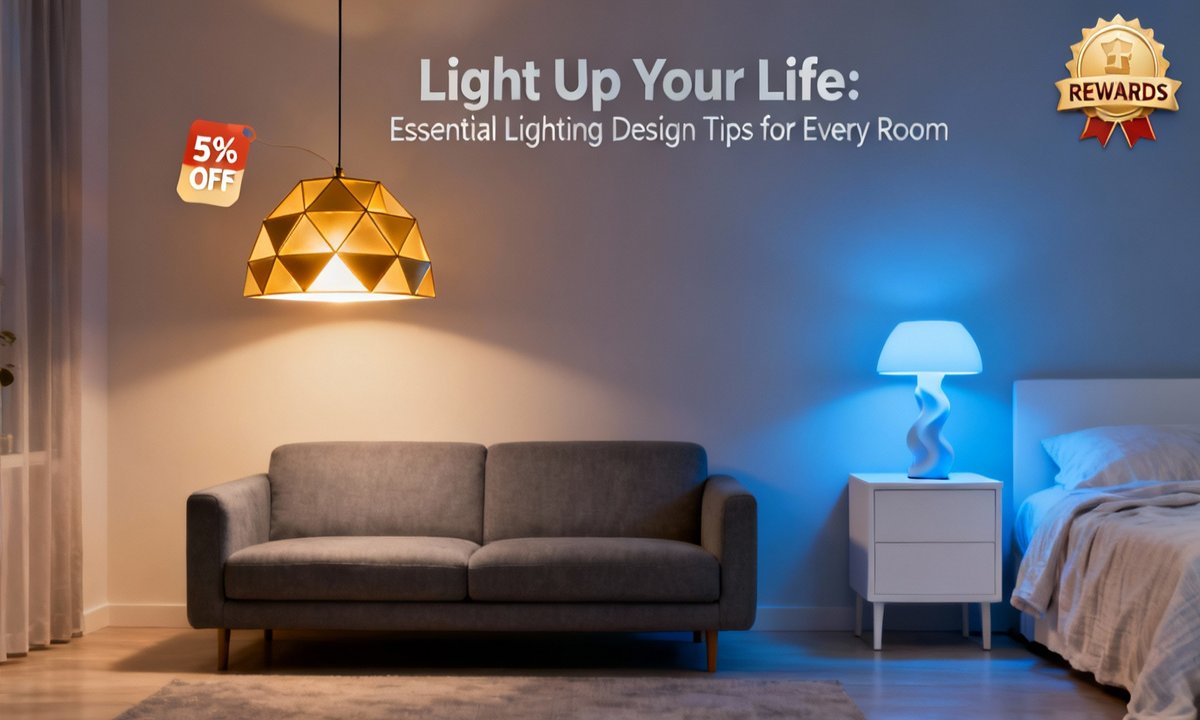Lighting profoundly transforms any space. Whether you’re refreshing a cozy corner or embarking on a full home makeover, the right lighting design tips are essential. They elevate comfort, enhance energy efficiency, and make your everyday spaces truly shine. Discover how to create a home that is functional, stylish, and perfectly tailored to you with these insightful lighting ideas.
The Power of Illumination: Why Lighting Matters
Effective lighting design extends far beyond simply flipping a switch. It actively shapes your mood, productivity, and relaxation at home. Strategic home lighting ideas are crucial for emphasizing comfort, promoting well-being, and beautifully showcasing your décor. A thoughtful lighting plan creates the ideal environment for family time, entertaining, or quiet downtime, boosting your overall mood and comfort levels.
Mastering Lighting Basics: Types, Layering, and Color Temperature
Achieving beautiful and functional spaces begins with strategically layering light. This involves three key components for comprehensive illumination. Ambient (general) light establishes the foundational glow, providing overall brightness throughout a room to set the mood and general visibility.
For specific activities, task lighting delivers focused brightness precisely where it’s needed, perfect for reading, cooking, or detailed work. Meanwhile, accent lighting skillfully highlights artwork, plants, or architectural details, introducing visual interest and depth. This thoughtful layering approach ensures both flexibility and a rich, dimensional quality in your interior design.
Selecting the Right Color Temperature for Optimal Comfort
Choosing the correct color temperature is vital for each room’s purpose. Warmer temperatures, ranging from 2700K to 3000K, feel incredibly inviting and are ideal for living rooms and bedrooms. In contrast, crisp 3500K to 4000K light is perfect for functional spaces like kitchens and bathrooms. Understanding how color temperature influences mood can significantly enhance your home’s atmosphere, as explored in articles like Mood-Boosting Interiors: Harnessing Color & Light for a Calming Home.
Picking Perfect Fixtures: Ceiling Lights and Floor Lamps
Ceiling lights serve as your primary source of ambient illumination, setting the overall brightness of a room. Floor lamps are excellent for adding focused task lighting and bringing an element of elegance to living rooms, home offices, or bedrooms. Whenever possible, choose dimmable fixtures to allow for customizable ambiance, adapting to any occasion or mood. Small changes in fixture selection can indeed make a big difference, as detailed in Transform Your Space: Budget-Friendly DIY Decor Ideas for Every Room.
Living Room Lighting Ideas: Creating Fixtures and Ambiance
The living room is a hub for entertaining, unwinding, and connecting with loved ones. A well-balanced lighting plan for this space seamlessly integrates ambient, task, and accent elements. Combine ceiling lights or stylish pendant fixtures with strategically placed table and floor lamps to achieve comprehensive illumination. For a touch of visual drama, use accent lighting to spotlight artwork, shelves, or cherished décor pieces.
Remember to soften overhead light by creating cozy pools of illumination within seating zones using dimmers. This technique adds inviting warmth, transforming movie nights or social gatherings into a truly special experience. For those prioritizing energy efficiency, smart bulbs combined with advanced LED technology can help lower electricity bills significantly. Discover more energy-saving strategies in Slash Your Electric Bill.
Key Insights for Living Room Lighting
When illuminating your living room, consider layering ambient ceiling lights, versatile floor lamps, specific task lighting, and thoughtful accent lighting. Direct spotlights are perfect for highlighting art or unique architectural features. Integrating dimmers offers exceptional flexibility for setting various moods and adjusting brightness to suit any activity, from lively entertaining to quiet relaxation.
Essential Kitchen Lighting Tips: Where Function Meets Style
The kitchen demands bright, even lighting to ensure safety and clarity for every culinary task. Layering lights like a professional involves several key components. Utilize ceiling lights, such as recessed LEDs, flush-mounts, or elegant linear pendants, for essential general illumination throughout the space.
Implement dedicated task lighting with under-cabinet strips, which are indispensable for safely preparing food and chopping ingredients. For an added stylish, designer touch, integrate accent lighting within cabinets or above islands, enhancing your kitchen’s overall aesthetic and visual appeal.
For optimal clarity in the kitchen, dimmers are highly recommended, paired with cool white bulbs (3000–4000K). Modern energy-efficient lighting solutions, including LEDs and sensor-activated switches, not only reduce energy consumption but also maintain a contemporary and sleek look. These choices contribute to a kitchen that is both brilliantly lit and environmentally conscious.
Key Insights for Kitchen Lighting
In the kitchen, always prioritize robust task lighting over counters and sinks to ensure clear visibility and safety during food preparation. Achieve a refined, designer aesthetic by balancing ambient lighting with strategic accent lighting. When selecting fixtures, opt for those that are easy to clean and feature high-efficacy LED technology for long-lasting, brilliant illumination that enhances both functionality and style.
Inviting Bedrooms: Lighting Design for Comfort and Mood
Bedrooms require gentle, restful light to foster an atmosphere of relaxation and tranquility. Your ideal bedroom lighting design should include warm ambient light, typically from fixtures on dimmers, perfect for winding down in the evenings. Integrate bedside table lamps or elegant wall sconces to provide focused task lighting for reading or other personal needs, enhancing both comfort and utility.
Further enhance a dreamy mood with accent lighting, such as delicate fairy lights or subtle LED strips. Layering light with soft color temperatures is crucial for maintaining a calm and serene space. For ultimate convenience, consider lamps equipped with USB charging ports and intuitive touch controls, seamlessly blending technology with comfort.
If you’re inspired by minimalist trends, explore Minimalist Home Decor Trends You Can Adopt Today. This resource offers streamlined and serene lighting ideas that align perfectly with a less-is-more aesthetic, ensuring your personal sanctuary is both tranquil and stylish.
Key Insights for Bedroom Lighting
For ultimate bedroom comfort, select warm color temperatures that promote relaxation and a cozy atmosphere. Enhance the room’s style and functionality by adding personal lamps or carefully placed accent lights. Incorporate dimmers to effortlessly transition between brighter settings for daily activities and softer, more soothing illumination for winding down, creating a truly adaptable personal sanctuary.
Bathroom Lighting Ideas: Combining Safety with Elegance
Bathrooms necessitate glare-free and shadow-free lighting to simplify grooming and makeup routines. Effective bathroom lighting ideas begin with vanity lights, ideally placed on both sides of the mirror to eliminate harsh shadows and provide even illumination, crucial for precise personal care.
Complement this with ceiling or recessed ambient lighting to ensure safe visibility throughout the entire space. Crucially, always select moisture-rated fixtures for all wet zones to guarantee safety, durability, and compliance with necessary regulations in a damp environment.
For clarity and a flattering appearance, use crisp yet gentle light, ideally between 3000K–3500K. Dimmable fixtures are an excellent choice for late-night routines, allowing you to soften the light as needed. To explore more efficient and modern lighting options for your bathrooms and other areas, consider reviewing insights from Home Energy Audit: Uncover Hidden Costs & Maximize Savings.
Key Insights for Bathroom Lighting
In your bathroom, prioritize creating even, bright light at the vanity area for essential grooming tasks. Always choose moisture-proof ceiling lights to ensure safety in damp environments. Opt for a color temperature that not only provides clarity but also flatters skin tones, enhancing your daily routines. These choices combine practical functionality with a touch of elegance.
Highlight with Accent Lighting: Showcasing Your Treasures
Accent lighting is a powerful tool for adding dimension and drawing attention to cherished items like artwork, plants, or built-in shelves. Use adjustable spotlights, subtle LED strips, or sophisticated wall washers to enhance architectural features. This strategic illumination provides a professional, designer touch, transforming ordinary spaces into captivating displays. It’s a key element in creating visual interest throughout your home.
Layer accent lighting thoughtfully with your base fixtures in living rooms, hallways, and entry areas. The result is a gallery-like atmosphere, adding extra depth and character to every corner of your home. Unleash your creativity and explore inspiring accent ideas in Transform Your Space: Budget-Friendly DIY Decor Ideas for Every Room, ensuring every spotlight truly makes a difference.
Energy-Efficient Lighting Solutions: LEDs, Controls, and Savings
Embracing green lighting technology does not mean compromising on style or aesthetic appeal. Modern building codes increasingly emphasize energy-efficient lighting and smart controls. Therefore, prioritize selecting LED fixtures that are ENERGY STAR® certified. Integrate occupancy and daylight sensors, along with dimmers and app-based smart lighting systems, for ultimate energy savings and enhanced convenience.
By upgrading to these solutions, you can significantly save money on utility bills, reduce your carbon footprint, and enjoy seamless comfort. If you are looking for even more effective ways to cut costs around your home, delve into Slash Your Electric Bill: Top 7 Smart Home Upgrades for Energy Savings for expert tips and actionable strategies to maximize efficiency.
Key Insights for Energy-Efficient Lighting
To optimize for energy efficiency, always use high-efficacy LED fixtures combined with smart controls. Transitioning to LED technology drastically lowers electric bills and reduces maintenance needs. Implementing sensors and dimmers allows your lighting to intelligently adapt to your daily routines and natural light availability, providing both comfort and significant savings.
The Golden Rule: Layering Light in Every Room
Regardless of the room, the fundamental principle of lighting design remains consistent: always blend ambient, task, and accent lights. This comprehensive method ensures that each zone within your home is both highly functional and aesthetically pleasing. It also provides invaluable adaptability for any activity, from quiet reading to lively entertaining. Find further inspiration to maximize well-being and style in Mood-Boosting Interiors.
Common Lighting Design Mistakes to Avoid
When planning your home’s illumination, be mindful to avoid common pitfalls that can diminish a space. Never rely solely on a single overhead ceiling light, as this often creates harsh glares and unflattering shadows. It is also crucial not to overlook task zones that require specific, focused brightness for activities such as reading or cooking.
Be discerning when selecting fixtures, ensuring you avoid bulbs that produce harsh or unflattering light. Finally, always remember to incorporate accent lighting. This essential element infuses personality and visual interest into your rooms, preventing them from feeling flat or uninspired.
As you plan, carefully map out the placement of switches and outlets to ensure they are conveniently accessible and enhance usability. For additional clever design hacks and helpful guidance on home improvements, explore insights from DIY Home Repair Hacks: Essential Tools & Skills to Save on Maintenance. These resources can help you refine your lighting strategy and tackle other home projects with confidence.
Your Actionable Lighting Checklist: Bringing it All Together
To begin optimizing your home’s lighting, first assess each room’s primary activities and specific lighting requirements. Next, ensure you layer the space effectively with a combination of ambient, task, and accent lighting. Critically, choose fixtures and bulbs that perfectly align with your desired color temperature goals for each area. Enhance flexibility by incorporating dimmers and smart controls wherever possible.
For bathrooms, always prioritize safety by using moisture-proof fixtures designed for wet environments. Thoughtfully highlight special features, such as artwork or architectural details, with targeted accent lights to create focal points.
Finally, commit to upgrading to LED technology and continuously optimize your lighting system for maximum energy efficiency. For a more sustainable home and deeper insights into eco-friendly choices, dive deeper with Sustainable Home: Eco-Friendly Products for a Greener Living Space.
FAQ: Expert Lighting Design Tips for Every Room
How can I effectively layer lighting in a bedroom?
In a bedroom, blend a central ceiling fixture or flush-mount for ambient light with table or wall lamps for task-specific reading. Add spot or strip accent lights to highlight décor. Dimmers are crucial for creating a soothing, adaptable atmosphere that caters to various moods and activities, from bright mornings to cozy evenings.
What is considered the best lighting approach for bathrooms?
For optimal bathroom lighting, place vanity lights on both sides of mirrors to minimize shadows, ensuring clear visibility for grooming. Complement this with moisture-safe ceiling fixtures for general illumination. Select bulbs with a color temperature around 3500K for clarity, which also provides a flattering light for personal care routines.
How can I significantly reduce my lighting-related energy bill?
To lower your energy bill, replace traditional bulbs with modern LEDs, install motion sensors in less-used areas, and utilize dimmers for adjustable brightness. Incorporate smart home integrations where feasible for automated control and increased efficiency. For comprehensive whole-home strategies, visit Slash Your Electric Bill for expert guidance.
What defines the difference between accent lighting and task lighting?
Task lighting is specifically designed to illuminate a particular activity, such as reading in a cozy armchair or chopping vegetables on a kitchen counter. In contrast, accent lighting is used to spotlight the aesthetic beauty of a room, highlighting elements like artwork, feature walls, or cherished plants to create visual interest and depth.
How do I choose the correct color temperature for my spaces?
For a warm and inviting atmosphere in bedrooms and living rooms, opt for a color temperature between 2700K–3000K. For enhanced clarity and functionality in kitchens and bathrooms, a range of 3000K–4000K is more suitable for task-oriented lighting. For detailed advice on how color impacts mood, see Mood-Boosting Interiors.
Share Your Personal Lighting Success Story!
Now that you’re equipped with essential lighting design tips for every room, it’s time to transform your vision into a luminous reality. We invite you to share your before-and-after photos, tell us about your favorite home lighting ideas, or reach out for personalized lighting advice. Keep your creativity glowing, and explore more budget-friendly home updates here or discover tomorrow’s exciting décor trends. Happy illuminating your perfect space!



